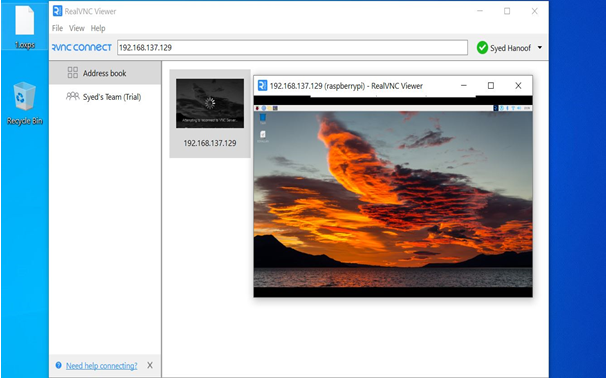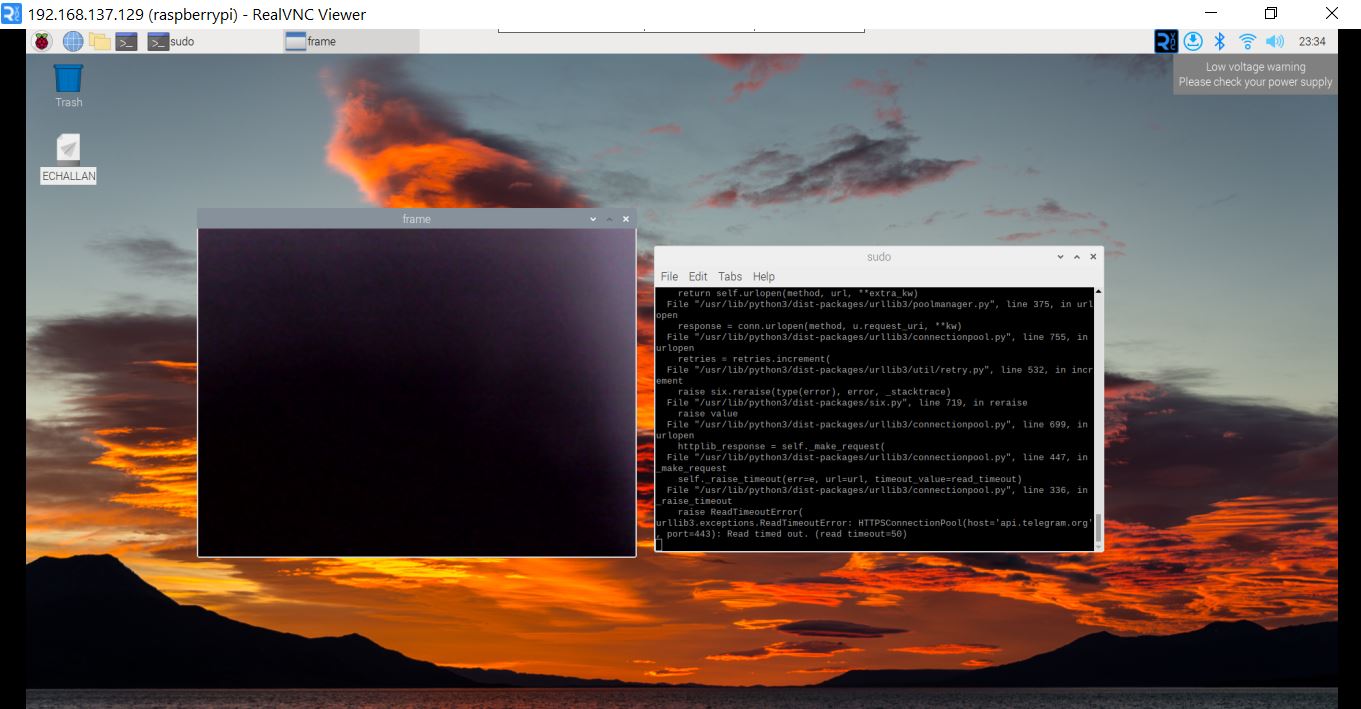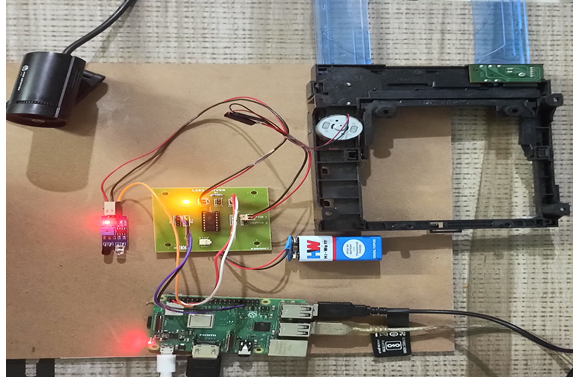Ijraset Journal For Research in Applied Science and Engineering Technology
- Home / Ijraset
- On This Page
- Abstract
- Introduction
- Conclusion
- References
- Copyright
AI-Enhanced Vehicle Plate Recognition for Urban Mobility
Authors: Syed Hanoof Ishaqi, Dr. Shanila Mahreen
DOI Link: https://doi.org/10.22214/ijraset.2024.65775
Certificate: View Certificate
Abstract
In recent times, there has been a significant rise in security concerns surrounding hotels, government complexes, and businesses, highlighting the need to identify authorized vehicles entering these premises. To address this, an automated platform has been developed that recognizes vehicles through their number plates. The system captures an image when the vehicle enters the camera\'s range, initiating the recognition process. To overcome the challenges involved, we have designed an intelligent access control system that employs a camera and recognition firmware for number plate scanning. The system compares the captured image with a database to retrieve the vehicle\'s data. This project interfaces with a Raspberry Pi and a laptop, and Python code is used to achieve the desired functionality. Additionally, the system offers features like challan status and insurance details for associated vehicles. If a vehicle has pending fines, the system sends updates via the Telegram app, allowing users to view and pay their fines directly, thereby enhancing the efficiency and user experience of the access control system.
Introduction
I. INTRODUCTION
In emerging economies, the daily increase in vehicle numbers is significant. Alongside this growth, the need for vehicle and number plate identification is also escalating. To meet this requirement, recent advancements have led to the development of automated vehicle number plate recognition systems. This research introduces an effective IVPR design with use of OpenCV technology. The model is created to automate recognition of vehicle plate through image processing. Nevertheless, the presence of non-standardized number plates poses challenges, as the diversity in designs can hinder accuracy.
A dedicated computer system which is derived to obtain functions, like processing, storing, accessing, and data management in devices is known as embedded systems. The system contains both hardware and software, the software is referred as firmware which is integrated to the hardware. An key feature of embedded system is the ability to gain output within the timeframe.
The recognition of vehicle number plates involves the automated process of identifying and reading registration plates using computer vision techniques. This method is formed to accurately capture the number plate number from picture or video footage of vehicles and has various uses, such as toll points, parking system, law department, and traffic monitoring.
The working of detection consists of several steps, beginning with capturing an image through a camera, followed by enhancing the image quality in the preprocessing block. In the feature extraction phase, important attributes like color, texture, and shape of the number plate are identified from the enhanced image. Lastly, a classification algorithm is used to compare the number plate number based on these identified features.

Figure 1: Embedded system block diagram
The detection of number plates serves several practical uses in modern times, including automated toll gate on highways, management of parking complexes, and identification of vehicles linked to criminal or theft. This area is a dynamic field of study within computer vision and machine learning, where researchers are continuously developing advanced methods to improve its characteristics features.
The work flow of vehicle number plate detection involves automated recognizing of number plate numbers using computer vision and image processing methods. The detection process typically begins with capturing an image or video of the vehicle through a camera.
Vehicle number plate detection technology can simplify various tasks that were previously done manually. This technology enhances the accuracy and efficiency characteristics of operations, resulting in low cost and smooth revenue. It utilizes computer vision and machine learning to automatically to catch vehicle number plates from images or video forms. Its primary goal is to enhance traffic safety and security, enabling law enforcement to quickly identify and monitor vehicles associated with criminal or theft activities.
The steps of detecting vehicle number involves several phases, including image enhancement, object localization, and its character identification. During the image improvement phase, the original image is refined so that it can be enhanced. Next, object localization phase uses various techniques, such as template matching, edge detection, or machine learning techniques to the identify the plate. The final phase, character identification, employs Optical Character Recognition (OCR) algorithms in interpreting its alphanumeric characters.
Applications for vehicle number plate detection are extensive and varied, This field is characterized by high advancements, followed by ongoing research and development aimed at improving the efficiency and accuracy characteristics. Furthermore, efforts are being made to ensure these systems can adapt to different type of contexts and languages while addressing important privacy concerns. As the technology for number plate detection evolves, it is increasingly important to balance technological advancements with ethical considerations. The integration of sophisticated algorithms and machine learning methods improves detection capabilities but also raises queries about data security and individual privacy.
II. LITERATURE SURVEY
- “Automatic License Plate Recognition (ALPR): A State of the Art Review by Rasheed et al. (2019)” - This paper delivers a complete examination of various ALPR systems, exploring the methods of image processing of the license plates.
- “License Plate Recognition: A Survey" by Hsieh et al. (2019)” - This comprehensive survey discusses the both traditional and modern methods of deep learning for license plate recognition, Outlining the existing challenges and potential future developments in the field.
- “Automatic Vehicle License Plate Recognition System: A Review by Singh and Sharma (2019)” - This review highlights a range of techniques employed in license plate recognition systems, including time tested methods like edge detection and template matching, also cutting-edge deep learning approaches.
- “License Plate Recognition System Based on Edge Detection and Neural Network by Qin et al. (2020)” - In this study paper, a system was proposed that utilizes edge detection in conjunction with neural networks to comprehensively identify and recognize license plates.
- “License Plate Recognition Using Deep Learning by Yin et al. (2017)” - This research introduces a technique for recognition that integration of a CNN with a RNN architecture.
A. Insights from Literature Survey
- Deep learning approaches are increasingly preferred in license plate recognition due to their ability to automated extraction features from various datasets.
- While old school methods such as edge detection and template matching are still commonly implemented, they are gradually being overshadowed by more advanced techniques.
- License plate recognition technologies serve a huge range of uses, including traffic enforcement, toll gate, and law management operations.
- A thorough review of the literature emphasizes the complexity and vital role of license plate recognition systems, along with latest efforts to improve their accuracy.
B. Literature Synthesis
In summary, the detection of vehicle number plates is quite important for several applications, including law management, toll gate, and parking management. Over the years, the field has seen significant advancements through the development of various methods and algorithms for detecting, segmenting, and recognizing license plates. Recently, deep learning methodologies have gained popularity, demonstrating impressive accuracy in license plate recognition tasks. Despite these developments, several challenges persist in current frameworks. There is a continued need for reliable detection recognition across different countries or regions. Improving accuracy and efficiency for real time usages.
Table I. Summary of Literature Survey
|
Sl. no |
Name |
Year |
Description |
Methodology |
|
1 |
M. M. Shidore, and S. P. Narote |
2011 |
Number Plate Recognition for Indian Vehicles |
Template matching, character segmentation |
|
2 |
Yin et al. |
2017 |
License Plate Recognition Using Deep Learning |
Deep learning, CNN-based approach |
|
3 |
Hsieh et al. |
2019 |
License Plate Recognition: A Survey |
Survey, various recognition techniques |
|
4 |
Rasheed et al |
2019 |
Automatic License Plate Recognition (ALPR): A State-of-the-Art Review |
Machine learning, feature extraction |
|
5 |
Qin et al. |
2020 |
License Plate Recognition System Based on Edge Detection and Neural Network |
Edge detection, neural network |
III. PROPOSED SYSTEM
All We have implemented a cost-effective strategy for vehicle number detection. The system consists of two main components: First is Raspberry Pi connected to a camera and an automatic boom barrier at the gates, while the other operates on a laptop where the machine learning code runs. When a vehicle approaches the camera, a specific character or string is transmitted to the Python code, which processes this input to identify the vehicle's number plate.
Upon successfully identifying the vehicle number, the corresponding character is send back towards the Raspberry Pi. The controller then checks whether vehicle is authorized or unauthorized. If the vehicle is authorized, the barrier will open using a motor driver and a DC motor. Conversely, if the vehicle is unauthorized, a notification will be sent to the relevant personnel.
A vehicle number plate detection system typically works on a deep learning approach, utilizing convolutional neural networks (CNNs) for effective object detection and recognition. Some major elements of the designed model are as follows:
- Image Acquisition: Vehicles that captures the images or videos using cameras or other imaging devices.
- Preprocessing: The captured images faces preprocessing to enhance their quality. This step includes noise reduction, adjustments to brightness and contrast, and resizing.
- Object Detection: The improved images are analyzed by a CNN, which identifies and locates the number plate.
- Character Segmentation: Identified number is segmented in to each individual character using technique such as connected component analysis.
- Character Recognition: The characters are then recognized using optical character recognition (OCR).
- Post-Processing: Recognized number plate number is refined to remove any inaccuracies or noise caused before being stored in a database or displayed on a screen.
This streamlined approach ensures accurate, efficient and reliable identification of number plate.
The introduced system provided several advantages over traditional methods, including enhanced accuracy and efficiency, particularly when dealing with large fleets of vehicles. Additionally, deep learning strategies are more adept at managing variations in lighting and weather, making them suitable for real-world applications. However, implementing this system may require significant computational resources. Furthermore, a sizable dataset examples will be necessary for training purposes.
A. Project design
The proposed module can be designed and implemented using open-source computer vision libraries such as OpenCV, alongside machine learning frameworks like TensorFlow and Keras. By training this module on a large dataset of number plate images, we can substantially improve its accuracy and reliability.
Additionally, this module has the capability to be integrated with other components to form a holistic vehicle management system.
When shaping the physical architecture of a automobile plate recognition system, its crucial to carefully select the hardware to smoothly capture and process images through computer vision and machine learning techniques. Important considerations include the choice of a high-resolution camera to ensure clear images of the number plates, which should be positioned to minimize glare while capturing the entire plate. The camera can either be fixed or mounted on a mobile platform to track the vehicle's movement. Good lighting is vital for obtaining high quality images, especially in low-light conditions, and options like infrared or LED lighting can be added to improve image clarity.
B. Figures and Tables

Figure 2: System layout

Figure 3: Proposed system block diagram
C. Methodology
This study focuses on identifying text from vehicle number plates using input images. It involves the localization of the number plate area to accurately extract each character. The existing literature showcases various processes for detecting and recognizing number plates. A significant challenge is the time needed for processing and recognizing specific number plates, which is crucial for real-time applications.
This method is tailored to each country because vehicle number plates have distinct color codes that changes across nations. The Connected Component Analysis (CCA) technique was utilized for accurately identifying area of the number plate. CCA streamlines the detection process by segmenting a image form in various elements. Spatial measurement is employed to assess the characteristics of a elements, while purification helps remove irrelevant superfluous elements. By integrating Connected Component Analysis with spatial measurement and filtering, the results of number plate detection are significantly enhanced.
D. Comparison with Existing system
The traditional system depends on a manual guard to monitor vehicle access at the gate, determining whether vehicles are authorized or unauthorized based on personal judgment. This guard typically assesses vehicles based on their prior knowledge of the drivers or familiarity with specific car models, rather than using technological tools for number plate recognition.
In manual vehicle number plate recognition, human operators visually identify and record number plate numbers from visually from images or video footage. This method is commonly used by law management and parking management when the vehicle volume is manageable, allowing for effective monitoring.
While manual detection can produce accurate results, it is labour required and time taking, especially during high traffic periods. The process is also susceptible to human error due to factors like fatigue or distractions, which can impact the accuracy of the readings. As a result, there has been a significant movement toward automated ad inteligent vehicle number plate detection systems that use both traditional and advanced deep learning techniques to efficiently manage large volumes of vehicles with minimum human input.
IV. RESULTS AND DISCUSSIONS
System includes a Raspberry Pi linked with camera and barrier. A laptop runs software that uses machine learning to read number plates. The system identify and read license plates by capturing images, enhancing quality, locating the plate, breaking it down and recognizing individual characters and making final adjustments for accuracy. According to the data, The user will get an update on telegram with the challan, insurance and theft status. User can also clear the dues via Telegram command. The raspberry Pi is controlled and viewed through VNC viewer on a laptop.

Figure 4: Simulation 1

Figure 5: Simulation 2
View Pi controller desktop OS through VNC viewer and take over the control. Run the number plate detection program with the shortcut created on desktop Program started, A pop up window is visible to identify and photograph the plate, when a vehicle is present. The captured image will be accessed by the program through machine learning algorithms that will be cross checked from the database. Command prompt also shows the actions that are being taken and output update, the same output will be obtained at telegram end.

Figure 6: Simulation 3

Figure 7: Model Hardware 1
The images shows the hardware interface in its basic form.

Figure 8: Model Hardware 2
Raspberry Pi is connected with USB, Display Sata through HDMI, Power supply from a adapter, further interconnected with motor and motor driver.

The images are captured through the camera as per the program and cross checked by the database.

Figure 10: Output data on telegram
Above shown output has been obtained at final at telegram application.
Conclusion
The initiative to detect vehicle number plates and update challan information represents a significant enhancement in leveraging machine learning and modern communication technologies to enhance vehicle monitoring and safety. By integrating the features such as real time challan notifications, verification of insurance status, and alerts for any number tampering, this project aims to not only improve user experiences but also strengthen compliance with regulations and promote public safety. While there may be challenges like including privacy considerations and technical limitations, the benefits of this initiative position it as a valuable asset for both individuals and government agencies. Ultimately, this groundbreaking system seeks to establish a safer, more informed, and efficient approach to vehicle management, creating the way for future innovations in smart transportation systems.
References
[1] Kasaei, S., & S. M. Kasaei. \"Recognition and Extraction of Vehicle License Plates in Outdoor Settings.\" IEEE, 2011. [2] Benson, Jonathan P., et al. \"Management of Car Parks Using Wireless Sensor Networks.\" In the Proceedings of the 31st IEEE Conference on Local Computer Networks, 2006, pp. 588-595. [3] Lee, Sangwon, Yoon, Dukhee, & Ghosh, Amitabha. \"Development of an Intelligent Parking Lot Application Leveraging Wireless Sensor Networks.\" In Proceedings of the International Symposium on Collaborative Technologies and Systems, 2008, pp. 48-57. [4] Diang, T. M., Makonnen, T. E., & Merkebu, A. Gebrehiwot. \"Vehicle Plate Recognition System.\" Fifth International Conference on Intelligent Network and Intelligent System, 2012. [5] Srikanth, S. V., et al. \"Prototype Design and Implementation of a Smart PARKing (SPARK) System Utilizing Wireless Sensor Networks.\" In Advanced Information Networking and Applications Workshops, 2009. [6] Anishiya, P., & Prof. S. Mary Joans. \"Utilizing Morphological Dilation and Erosion with OCR for Number Plate Recognition in Indian Vehicles.\" International Conference on Information and Network Technology, Vol. 4, 2011. [7] Kamat, & S. Ganesan. \"Effective Application of the Hough Transform for License Plate Detection Using Digital Signal Processors.\" In Proceedings of the Real-Time Technology and Applications Symposium, 1995, pp. 58-59.
Copyright
Copyright © 2024 Syed Hanoof Ishaqi, Dr. Shanila Mahreen. This is an open access article distributed under the Creative Commons Attribution License, which permits unrestricted use, distribution, and reproduction in any medium, provided the original work is properly cited.

Download Paper
Paper Id : IJRASET65775
Publish Date : 2024-12-06
ISSN : 2321-9653
Publisher Name : IJRASET
DOI Link : Click Here
 Submit Paper Online
Submit Paper Online

